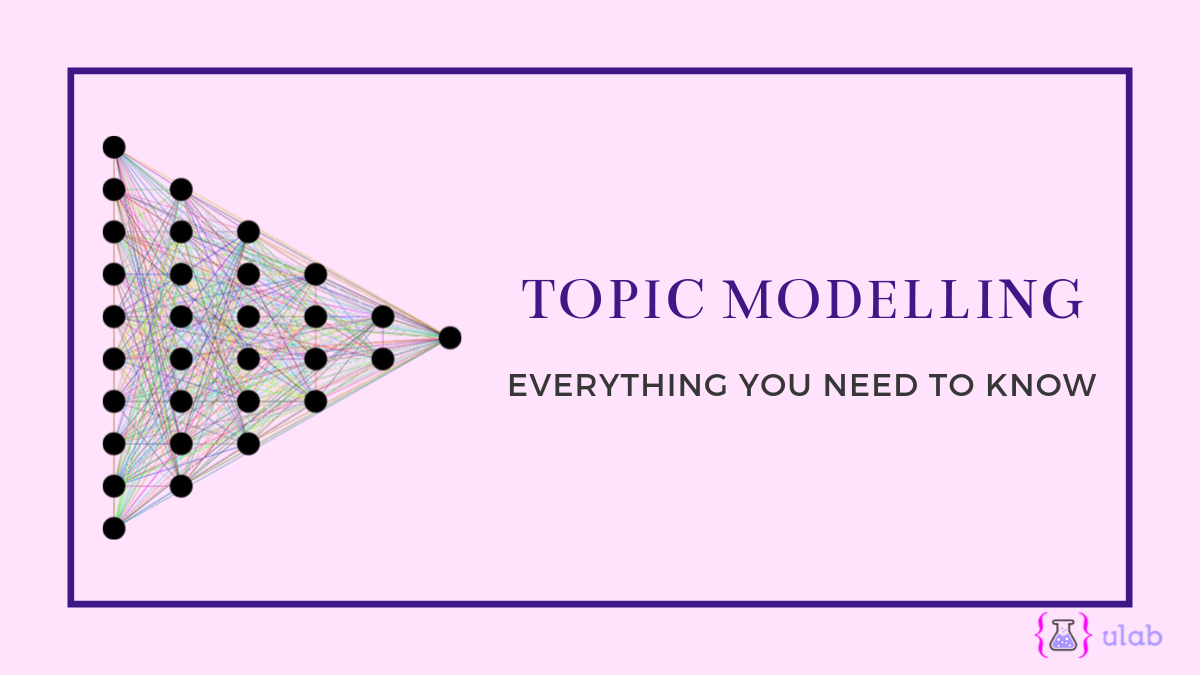Topic Modelling – Everything you Need to Know

We’re now living in a world where data inputs are as common as breathing. Regardless of how much we focus on different forms of visual and audio content, the root of it remains to be the text. However, until we’re able to analyse the data and the patterns behind it, the data bundles are all meaningless yet potential resources. Enterprises that have realised the importance of data mining and interpretation, have been able to beat their competitors and pre-empted all others in devising strategies that are informed and data-driven.
However, before we delve into the utter need of interpreting that data or leveraging it, there remains a question that whether this analysis is possible even? If yes, is there a point we do it manually? Indeed not.
The advent of technologies such as Artificial Intelligence and Machine Learning, executed primarily through Python, have made lives a lot easier both for engineers and their employers – the business propellers.
Topic Modelling is one such boon emerging as a part of AI and ML where the tools and packages can automate the analysis of text. Suppose, you have a huge bundle of text lying in front of you. These could be assorted data points gathered from different sources or could be pieces of information put together to bring out a common topic form. These could also include video or audio transcriptions converted into plain text. Now, if someone asks you find patterns behind this data, you may choose to do it manually and invest your valuable time and energy.
Wouldn’t it be amazing to know that a machine can do it for you?
What is Topic Modelling?
This is an AI-based automated technique that extracts the common topic that is being discussed across huge volumes of text. So, a human working on the analysis of data does not have to literally read through the words to interpret it. Packages designed for topic modelling in Python work by extracting not just single but up to 10 topics out of the data piles.
How Does Topic Modelling work?
Taking Python as the basis, topic modelling packages work by first identifying the different topic categories in a source of text and then putting together similar words under these topics. So, basically, topic modelling works by mining and categorization or structuring of relevant text under respective sections. It works in various iterations until the final model is produced.
A topic model framework works towards extracting meaning in a black box – freeing up the human brain to perform more complex functions at an advanced stage.
When Should you use Topic Modelling?
As the world is slowing embracing digitization and digitalization, organizing documents becomes a bit too tedious for departments. If you wish to organize them, you might still have to open and read through each document to manually put them under one folder. Now imagine an enterprise that has multiple departments and within than multiple such documents are produced and access every minute.
There are functions such as Admin, Finance, Human Resources, Security etc. Further, they have several client-facing functions and databases. Now, would you expect their data analytics or warehousing teams to manually look for documents or organize them each time a cross-functional team demands a certain reference? Would that even be possible with a click?
Topic Modelling is one such technique that promises to potentially do away with that challenge. It cannot just enable the operational aspects of an organization but also empower the Sales and Marketing teams. The Sales and Marketing wings form the fountainhead of every organization and their basic food for processes is content — majorly existing in a text form. Isn’t it? Each time a writer has to create or repurpose an asset to tailor it to match the new query, do you think doing it manually would be a cakewalk? Indeed not. But using topic modelling, he or she can quickly extract the relevant inputs out of multiple existing collateral and use that information to create a custom, repurposed document.
Intrigued? Read on.
What are the Top Features and Functions Involved in Topic Modelling?
- Topic Visualization – This is about presenting the initial results after the various topics get identified from the source file corpus. Visualization helps you get started with the clustering and formation of subsets.
- Automatic Data Processing – The data processing takes place through an algorithm that segregates topics and places similar-looking words under different buckets. So, this is about segmenting the common words to narrow down the topic identification.
- Data Auditing – At this step, the data is cleared out to remove any undue or meaningless punctuations, or numbers or special characters. This step helps in filtering out the unwanted stuff – so that only relevant words remain in the document.
- Topic Clustering – This step ensures that the entire document is divided into clusters of documents on the basis of structure. Here, the actual separation and sourcing of topics begins. The clusters eventually churn out the topics.
- Frequency Filters – Here the terms are organized as per the frequency of their occurrence. High-frequency terms appear better than low-frequency ones. Frequency defines the extent of discussion around a specific topic in a document. That helps shape the topics.
- Speech Tag Filtering – This is an advanced form of filtering that focusses on the context of the features. The more contextual ones appear when you apply it. At this step, we race towards the topic selection based on the frequencies and context.
What are various approaches to Topic Modelling?
Latent Dirichlet Allocation
This method involves interpretation of data, observing and explaining why some of the text portions are similar in nature and how these could be combined further to derive meaningful insights. It easily picks up topics that use smaller words.
Latent Semantic Analysis
This model is credited with finding relevance in complex words. It works through indexing of low-rank approximations. This one works in best combination with Gensim corpus. This analysis can find relevant in digital content marketing works such as search engine optimizations. Many marketers are in the process of creating use cases around these. Some popular marketing automation companies such as HubSpot are already using it.
Natural Language Processing
This is the simplest of all methodologies, working through optical character recognition and computing of similar words. It supports nearly all the topic modelling packages based on Python. It is capable of even speech and recognition and data analysis in the scripts for chatbots, etc. This can form an effective combination with the above two models.
References for further reading:
Tutorials:
Articles:
A Stepwise Introduction to Topic Modeling using Latent Semantic Analysis (using Python)
Beginners Guide to Topic Modeling in Python
Ebook:
Building Machine Learning Systems with Python
Summing Up
Topic modelling is a relatively new yet promising data mining automation process. Some of its greatest advantages include the machine-led segregation, structuring and analysis of text to find meaning in huge data piles. However, the challenges remain in the pre-processing to yield effective results through the packages. You need to still carry out manual tokenization before inputting the text. This remains debatable that does it then really ease out the human efforts in data mining and interpretation.
If you would like to add anything, your comments and suggestions are welcome. If you have questions, rather, we’d be glad to address them. Connect with us through the comments section below.

